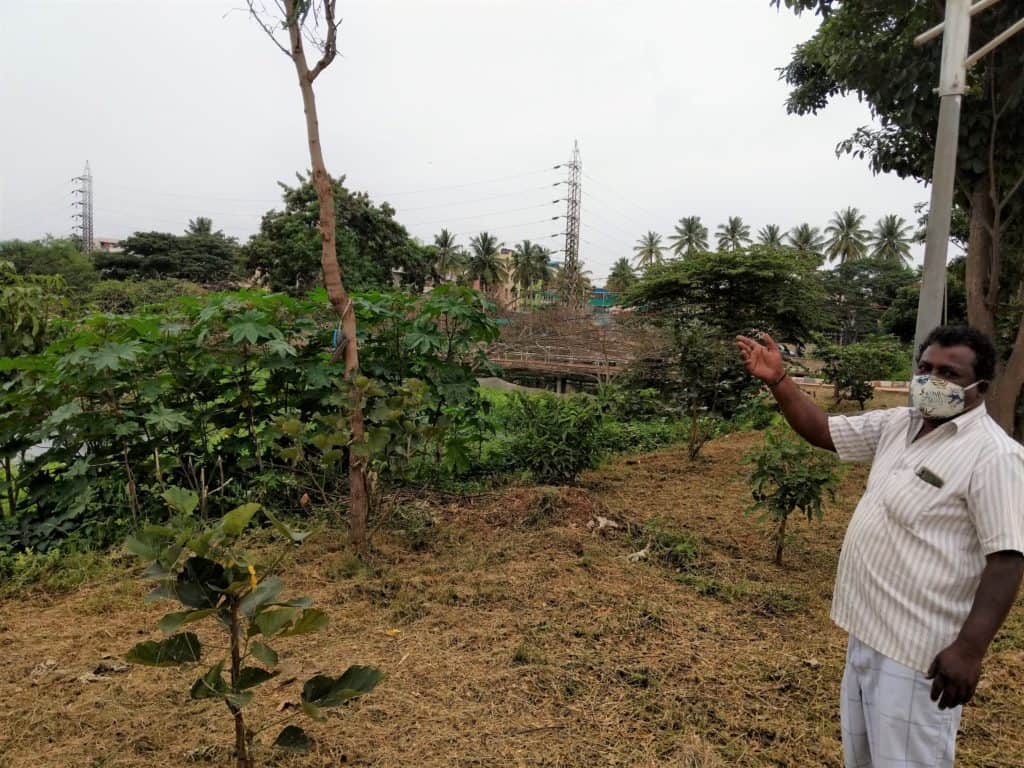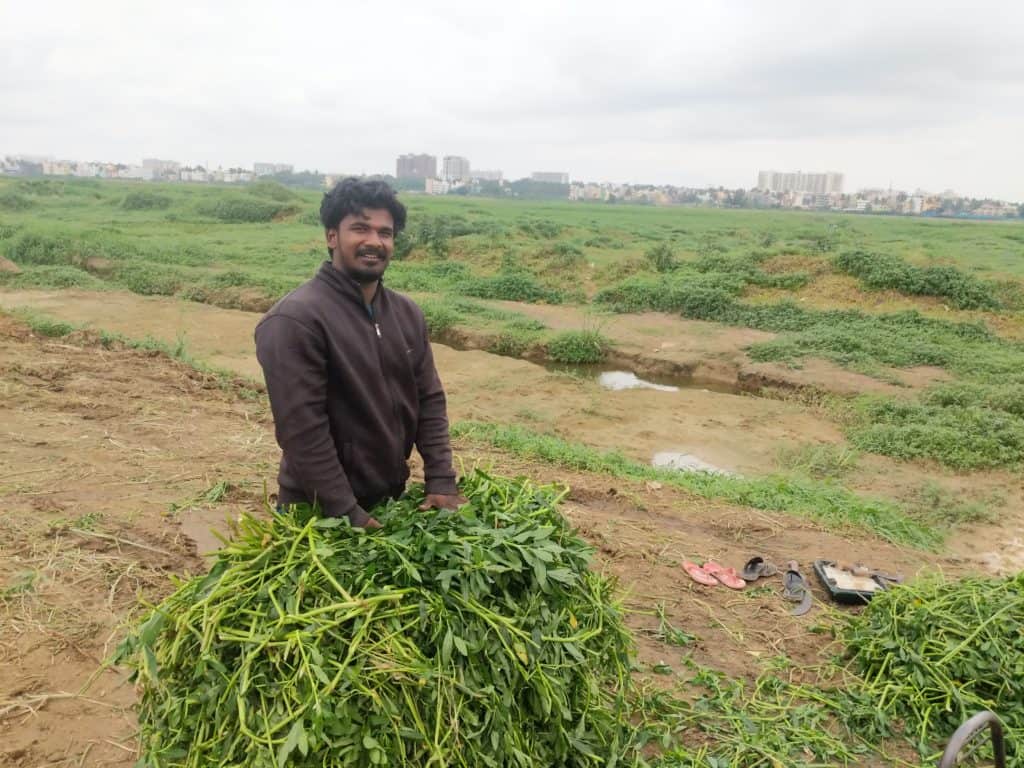[In Part 1 of this series, we saw how Bengaluru’s lakes used to provide food and livelihoods to communities living around them, and how this has been lost over time. In this part, we explore solutions to the problem.]
The afforestation and tree planting schemes around Bengaluru’s lakes do not seem to believe livelihood is a priority. For example, the banks of Kalkere lake now sport a variety of exotic species including palm trees, instead of honge and tamarind trees that local residents once depended on.
Even lake rejuvenation often has been for recreational value, with the lake bed scooped out in a soup-bowl design that affects biodiversity, and restricts the access of cattle herders and others who depend on the lake for greens and fish. The sweep of gentrification is pushing pastoral practices out of the city as well.
Seema Mundoli, a senior lecturer at Azim Premji University (APU) who has researched urban commons in Bengaluru, says, “There is a perception among urban planners that if you plant fruiting trees or economically useful trees, then people will fight over access. Who has the right to collect the seeds and fruits may become tricky. But, there are community-based solutions to these questions.”
For instance, Delhi has been managing the harvesting of jamun trees through tenders for collections and sales. Seema says, “This is a traditional practice; people camp under trees to protect their jamun harvest. In Bengaluru, we could look at ward-level communities for the management of these commons – income generation through the sale of seeds and fruits or, collection of greens and reeds from lakes.”
Harini Nagendra, also from APU and a prolific author and researcher of biodiversity in the city, notes urban incomes can be supplemented if biodiversity is conserved from a livelihood lens rather than just an aesthetic lens.
She says, “In the markets of Banashankari, you find tens of varieties of soppus, medicinal plants and herbs foraged from spaces around Bengaluru. Women or people who are out of jobs forage to supplement income. Encouraging these livelihoods becomes about sustainability, food security and reducing carbon footprint for the city. It is also about protecting traditional knowledge.”
Livelihood protection means biodiversity protection too
These livelihoods in turn play an important role in conserving biodiversity. Jakkur and Kaikondrahalli lakes’ community-centric lake rejuvenation models showcase this success. Here, cowherds, grazers, farmers and fishermen were involved with rejuvenation, ensuring the close-knit relationship between society and the lake continues.
Harini says, “These lakes get treated water from sewage treatment plants. But, it still has high nitrogen and phosphorus content that is absorbed in the wetlands. You’d need to remove the grass from the wetland regularly to encourage plant growth. Grazing then becomes an important biodiversity service.”
‘Meen’ Yellappa and his group of 50 fishermen, who have won fishing rights over the newly-rejuvenated Agara Lake, have been using their traditional knowledge to help civic bodies make the lake more hospitable not just for walkers, but for foragers, cattle herders, and flora and fauna.

“If left to the city corporation, they’d keep clearing weeds entirely from the lake. We had to tell them to leave some in the borders and in the corners of the lake. This is crucial for birds to lay their eggs, for insects on which fish and birds feed, and for fish themselves,” he says.
People like Yellappa do more than just survive on the lake. They ensure it thrives. They keep their eyes out not just for fish to catch, but also for catfish. “Catfish can eat up to 2 kg of local fish a day. It can destroy entire ecosystems,” he says. The group expects to catch over 50 tonnes of fish over the next three years, including Rohu, Catla, Common Carp, Mirgal and Jalebi.
Their experience is also indicative of why economic benefit from lakes should be distributed among locals primarily rather than outsourced to fishing firms. The fishermen clear aquatic weeds – using some for manure, and some as fodder for the over 10 cattle herders that depend on them.
Four varieties of greens grown on the banks of the lake and Garke (Cynodon dactylon which is used for religious rituals and ayurvedic practices) are harvested by around five low-income households. Honge trees by the banks are harvested for seeds before Ugadi, and Yellappa estimates each fisherman earns around Rs 3,000 through this. “Through all this, we don’t really need to extract fish through the year. We take a break during the monsoons so that the fish population can recuperate,” he says.
Furthermore, the fishermen, who were befuddled by the planting of palm trees and other exotic species, have planted Agse (Sesbania grandiflora or Hummingbird tree), Indian Fig Tree and Jamaican Cherry Tree (Gasagase in Kannada) whose fruits can be consumed. “At the least, anyone hungry in the park will find something to eat,” says Yellappa.
Can Varthur lake revival save livelihoods?
There is frenetic activity in the wetlands of Varthur lake, which is at the start of a long road towards a National Green Tribunal-monitored rejuvenation. Bikes, autorickshaws, small goods vehicles make their way towards swathes of 10-foot-high grass that cover the emptied out lake bed.
For nearly a decade now, 22-year-old Ravi, a college drop-out, has relied on Varthur’s grass to feed his six heads of cattle. Each day, he makes a trip on his two-stroke bike, carrying nearly 200 kg of fodder in four trips.
“Traditional grazing spots have been reducing, and more and more farmers have been coming to the lake to take fodder. But this lake is so big that it can cater to us all,” he says.

There is an initial tremor of excitement at the imagination of the lake filling up with clean water and the stench of sewage reducing. But, there is a concern. “I hope that they (civic authorities) leave at least 100-150 acres as wetlands for us. If they don’t do this, I will have to sell my cows,” Ravi says.
The civic organisation Varthur Rising’s Jagadish Reddy, who is keenly following rejuvenation efforts, says they will ensure that access to the lake is not compromised during rejuvenation. After all, the lake is a key part of Varthur village’s economy.
Jagdish says, “This lake is important for cattle herders and farmers up to 5 km away. It can’t just be for recreational purposes. It is an important part of local livelihood and local memory. We can’t lose it.”
This article is part of a series on ‘Bengaluru’s Ecosystems and Biodiversity’. This is a joint project with Mongabay India, and is supported by the Bengaluru Sustainability Forum (BSF).